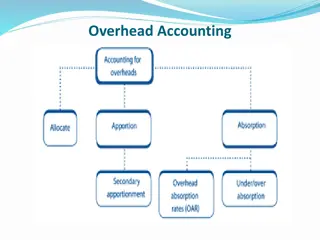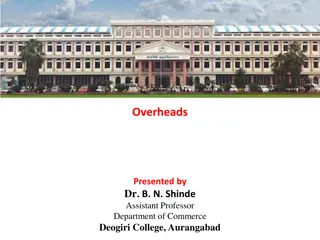Techniques for Additional Overhead Reduction in Mixed Beamforming Feedback
Explore the properties of Mixed Beamforming (Mixed BF) and discover a method to reduce feedback size while maintaining high performance. Dive into the analysis of narrowband precoder properties to identify opportunities for size reduction without significant impact on total power. Enhance your understanding of feedback reduction techniques in the context of IEEE 802.11 standards.
Download Presentation

Please find below an Image/Link to download the presentation.
The content on the website is provided AS IS for your information and personal use only. It may not be sold, licensed, or shared on other websites without obtaining consent from the author.If you encounter any issues during the download, it is possible that the publisher has removed the file from their server.
You are allowed to download the files provided on this website for personal or commercial use, subject to the condition that they are used lawfully. All files are the property of their respective owners.
The content on the website is provided AS IS for your information and personal use only. It may not be sold, licensed, or shared on other websites without obtaining consent from the author.
E N D
Presentation Transcript
January 2020 Additional Overhead Reduction in Mixed BF Feedback Date: 01-01-2020 doc.: IEEE 802.11-20/41r0 Authors: Name Genadiy Tsodik Affiliations Address Phone email Shimi Shilo Huawei Submission Slide 1 Genadiy Tsodik (Huawei)
January 2020 doc.: IEEE 802.11-20/41r0 Introduction Many contributions have discussed the topic of feedback size reduction and what directions may be used for next generation [1],[2],[3] Mixed Beamforming (Mixed BF) where the precoder is constructed by two components (wideband and narrowband) was presented in [2] and [3] as a candidate for 802.11be In [4] we studied the properties of Mixed BF where the difference between the wideband and the narrowband part was analyzed in detail The main aspect was the limited impact of narrowband component on the equivalent SNR and the performance of Mixed BF In this contribution we want to continue investigating Mixed BF properties, and show a technique that allows additional feedback size reduction with negligible or zero degradation of the performance Submission Slide 2 Genadiy Tsodik (Huawei)
January 2020 doc.: IEEE 802.11-20/41r0 Re-Cap Narrowband Properties The main property studied in [4] was the impact of the narrowband component of Mixed BF (shown in the diagram below) on the SNR We showed that the wideband component of Mixed BF mostly defines the beam directions of the beamformed DL transmission, whereas the narrowband part yields a per-tone fine phase adjustment We also presented the Zero-Forcing post-processing SNR provided by Mixed BF and showed that the narrowband component contributes very little to it Following this observation we may consider accuracy relaxation for the narrowband part (i.e. smaller feedback size ) with no DL performance degradation ?? - per tone channel matrix NxM ??= ????? NxK ??? ??? ??? NxK Wideband Precoder Calculation Narrowband Equivalent Matrix Calculation Narrowband Precoder Calculation Submission Slide 3 Genadiy Tsodik (Huawei)
January 2020 doc.: IEEE 802.11-20/41r0 Narrowband Precoder Properties We further study the properties of the narrowband precoder in order to find a technique that may be applied for feedback size reduction We examined the power of the entries of the ??? matrix (the narrowband component) to understand the contribution of each entry to the total power of each column, i.e. impact on per-stream SNR The figure on the right shows the histogram of the entries of 2x16 ??? matrices obtained from ~3000 realizations of the TGn-D channel We can see that more than 20% of the entries have a power below 0.01 (of total unit power) This means we can ignore very small values of the V-matrix and reduce the feedback size of Mixed BF by an additional ~20% with very small reduction in total power Power Submission Slide 4
January 2020 doc.: IEEE 802.11-20/41r0 Main Concept The main concept is to select those entries of the narrowband V-matrix that contribute the majority of the total power and null the rest The selection might be done based on some arbitrary threshold (entries below the threshold will be nulled) or by nulling a constant number of (lowest) entries; at each column of V-matrix different entries may be selected Selected entries are not included in feedback data which means feedback size will be reduced by the number of nulled entries The diagram of Mixed BF with nulling entries of narrowband V-matrix is shown below (Ksel corresponds to the number of selected entries per column) ?? - per tone channel matrix NxM ??? ??= ????? NxK ??? ??? ??? NxK Nx(K-Ksel) Wideband Precoder Calculation Narrowband Equivalent Matrix Calculation Narrowband Precoder Calculation Entries Nulling Update Narrowband Precoder Submission Slide 5
January 2020 doc.: IEEE 802.11-20/41r0 Impact on SNR In order to justify the idea to ignore (null) small values of the narrowband V-matrix we first look at the impact on the post-processing SNR We compared the PPSNR of the original narrowband V-matrix (without nulling) and V-matrix where some of the entries are nulled We nulled on average ~25% of the entries In the figure on the right we can see that in ~80% of the cases the SNR difference is below 60dB, while in all the cases it is below 30dB, which means no degradation of the performance Submission Slide 6 Genadiy Tsodik (Huawei)
January 2020 doc.: IEEE 802.11-20/41r0 Method Applicability In order to study the applicability of this concept we checked the number of rows that contribute the least at each channel sounding Per channel realization, we calculated at each tone the number of rows below the threshold of 0.05 and averaged over the entire 20MHz BW We can see in the figure on the right that the average number depends on the initial K value and reduces with K (additional observation is given in the Appendix) Following this observation we understand that the beamformee can choose the required number of rows according to the selected K value and manage the desired feedback size Submission Slide 7
January 2020 doc.: IEEE 802.11-20/41r0 Simulation Results We complete the analysis of the idea by simulating two different scenarios: MU-MIMO with 2 STAs, Nss = 2 each, 16Tx Ant in this case we compared between K=6 (wideband precoder size) and K = 10 with nulling of ~3 entries per column of narrowband V-matrix MU-MIMO with 3 STAs, Nss= 2 each, 16 Tx Ant in this case we compared between regular explicit precoder and mixed BF using K = 16 (no size reduction of wideband part) and nulling of ~5-6 entries per column of narrowband V-matrix We can see in the figures below that in both cases nulling of the V-matrix entries results in no degradation in the performance while the overhead may be further reduced by 25%-35% 69% Reduction 50% Reduction 63% Reduction 35% Reduction Submission Slide 8 Genadiy Tsodik (Huawei)
January 2020 doc.: IEEE 802.11-20/41r0 Feedback Size Summary We showed in [4] that Mixed BF can lead to significant feedback size reduction Here we present an additional feedback size reduction that can be achieved by applying nulling on the entries of the narrowband precoder matrix We can see in the table below that in all the cases where nulling is applicable the feedback size is further reduced by up to ~25% Moreover in case K=N_Tx (e.g. last row) we can achieve 35% of feedback size reduction with no performance degradation Nc Na Na Feedback Size Reduction with Nulling % Na Feedback Size Reduction % Performance Loss Nc (Nss) per User Nusers K Per-Tone Precoder Mixed BF with Nulling Mixed BF 8 8 2 2 2 2 2 4 2 6 2 3 6 4 26 26 58 58 58 18 10 42 34 58 12 4 42 22 38 31 62 28 42 0 0.2dB 0.5dB 0.2dB 0.2dB <0.1dB 54 85 28 63 35 16 16 16 12 10 16 Presented on previous slide Submission Slide 9 Genadiy Tsodik (Huawei)
January 2020 doc.: IEEE 802.11-20/41r0 Conclusions Mixed BF properties were analyzed with respect to minimizing feedback size Relaxed accuracy of narrowband precoder allows additional feedback size reduction with no degradation of the performance Entries nulling is a simple technique that can implement accuracy reduction with easy adjustment to performance requirements Moreover nulling may be applied for backward compatible use-case where wideband component has no size reduction Summarizing all the details presented above and in [4] Mixed BF is a promising method to be adopted by 802.11be for feedback size reduction Submission Slide 10 Genadiy Tsodik (Huawei)
January 2020 doc.: IEEE 802.11-20/41r0 References [1] 11-18/1231r6-0eht-eht-draft-proposed-par. [2] 11-18-1184-01-0eht-eht-discussions-on-throughput-enhancement [3] 11-19-0391-00-0eht-feedback-overhead-reduction-in-802-11be [4] 11-19-1115-00-00be-reduced-beamforming-feedback-for-802-11be Submission Slide 11 Genadiy Tsodik (Huawei)
January 2020 doc.: IEEE 802.11-20/41r0 Appendix The figures below present a power of six lowest entries of narrowband component and also an accumulated power (corresponds to power reduction in case of nulling) We can see that in majority of the cases we can null 4-6 entries with less 10% reduction of total power Submission Slide 12 Genadiy Tsodik (Huawei)























